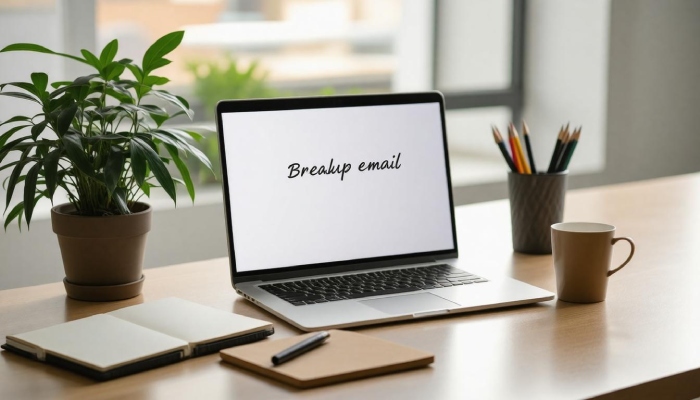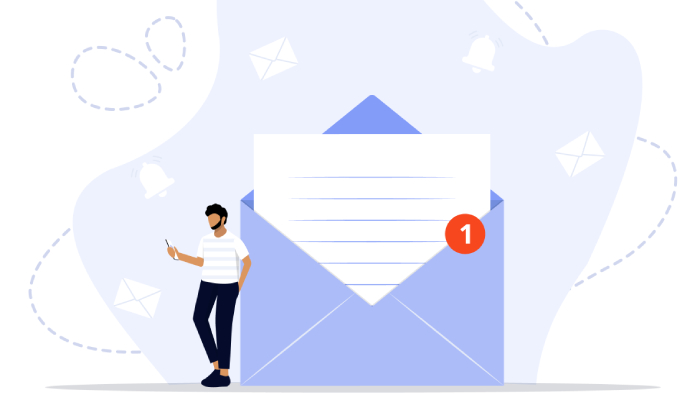Sales Breakup Email: Effective Templates and Strategies for Success
Sales can sometimes feel like a tricky dance, where one misstep can lead to silence instead of a two-step closer to closing a deal. If you’ve ever found yourself feeling stuck after sending multiple emails and getting little to no response, you’re not alone. Many sales professionals face this frustrating conundrum, and that’s where the concept of a sales breakup email comes into play.
This final outreach isn’t just about waving goodbye; it’s your opportunity to either reignite a conversation or respectfully close the door. In this guide, we’ll explore how to craft effective breakup emails that keep the lines of communication open, all while helping you focus on your most interesting leads. Understanding this strategy is like unlocking a new level in your sales journey—it can help clarify your efforts and make your follow-ups more impactful.
A sales breakup email is a final communication sent to prospects who have not engaged after multiple outreach attempts, aimed at either re-engaging them or definitively closing the conversation. It typically includes a clear subject line, personalization, and a concise call-to-action that encourages the recipient to express their interest level, ultimately helping sales professionals prioritize their leads more effectively.
Crafting a Sales Breakup Email

At its core, a sales breakup email should strike a delicate balance between empathy and assertiveness. You want to convey understanding of your prospect’s situation while also asserting that this is likely your last attempt to reconnect. This duality can be challenging; however, using clear language and thoughtful phrasing can make it effortless.
When you begin the email with an acknowledgment of their busy schedule—something like, “I completely understand how hectic things can get”—you lay a foundation of empathy that resonates with them.
Following this opening, the message should seamlessly transition into your true intention: gauging their interest. Use phrases that leave little room for misinterpretation, such as, “If you’ve decided our solution isn’t right for you at this time, please let me know.” Not only does this show respect for their time, but it also places the ball firmly in their court, encouraging a response.
Now, let’s focus on how to structure this email effectively.
Structuring Your Email
A well-structured breakup email follows a logical flow that eases the prospect into your main point without overwhelming them. Start with an engaging subject line that draws them in; something like “Quick Check-In” or “Where Do We Stand?” can pique curiosity.
After starting with a warm greeting and acknowledging their silence, clearly state your purpose. This part should be concise yet effective—perhaps say something like, “This will be my final outreach regarding [Your Service/Offering]. I wanted to check in to see if you’re still interested.” Here, you minimize ambiguity and direct attention back on them.
- Empathy Focus: Make your first couple of sentences about them, reinforcing their circumstances.
- Purpose Statement: Clearly state why you are writing.
- Final Options:Consider offering limited choices to avoid overwhelming them. For example:
- “A: I’m still interested.”
- “B: Let’s reconnect later.”
- “C: Please unsubscribe me.”
Each choice prompts reflection on the prospect’s part and prepares them for an eventual conclusion or re-engagement.
Finally, don’t forget to wrap it up!
End your email positively by expressing gratitude for their time and consideration—this leaves the door open for future opportunities. You can add something like, “I appreciate our previous conversations and hope to hear from you soon!” This final touch keeps your tone friendly and inviting rather than pushing them away.
By combining thoughtful empathy with directness and structuring your message clearly while guiding prospects through potential responses, you enhance your chances of rekindling interest and achieving positive outcomes.
With these elements in mind, it’s essential to dive deeper into crafting messages that resonate effectively within the broader narrative of maintaining successful communication strategies.
Structuring the Perfect Message

The structure of your email can make a world of difference in how it’s received. An effective breakup email is not just about delivering a message; it’s about crafting communication that hooks the reader right from the subject line.
1. Clear, Engaging Subject Line
Your subject line acts as the first impression and can significantly influence whether your email is opened or ignored. Short, compelling subject lines, such as “Where do we stand?” or “Should I close your file?” generate curiosity and incite urgency, prompting a quicker response that helps you gauge interest without excessive wait time.
Research shows that approximately 40% of recipients decide whether to open an email based solely on the subject line. Craft yours with intention.
2. Personalized Opening
After your subject line has done its job, the opening of your email must continue that momentum. Start with a friendly greeting like “Hi [Prospect’s Name],” while incorporating a personalized reference to past interactions. For instance, saying, “I hope the project we discussed is going well,” implies that you value the relationship and still remember the specifics of their needs. This personal touch can create a connection that encourages engagement.
3. Brief Reminder of Value Proposition
As the conversation progresses, don’t forget to remind them why you reached out in the first place. Use a quick recap of your product or service’s benefits tailored to their needs. A succinct statement like, “Our solution could save your team 30% on operational costs,” reiterates your value proposition while sparking their interest in re-engaging.
4. Call to Action
Now, it’s time to give clear guidance on what you want from them—this is where the call to action comes into play. Phrasing such as, “Please let me know if you’d like to schedule a quick call or if now’s not the right time,” makes it easy for them to respond with clarity about their preference for future communication.
A strong call to action is vital; including one increases your chances of obtaining a response by about 30%.
5. Polite Closing
Finally, conclude your email politely but decisively, ensuring there are no hard feelings regardless of their decision. A simple “Looking forward to hearing from you,” followed by “Best, [Your Name],” leaves the door open for future interactions while remaining respectful of their choice.
With these fundamental elements well-structured within your email, you’ll be well-equipped as you consider when to send these impactful messages for optimal engagement.
Timing for Sending Breakup Emails

Effective communication isn’t just about what you say; it’s also about when you say it. If you send a breakup email at the wrong time, it may go unnoticed or be ignored altogether. Research reveals that prospects typically require eight to twelve touchpoints before responding, but how you space these out is crucial. It’s like setting the stage for a presentation—if the timing is off, your message could fall flat, irrespective of its content.
Ideal Timeframes
The first key timeframe to remember is to send your breakup email after several unanswered attempts. Specifically, it’s advised to wait until you’ve made at least five outreach attempts over two to three weeks. This duration shows persistence without coming across as desperate. Think of it like nurturing a plant; it takes time for seeds to grow and flourish, and engaging potential clients requires consistent follow-ups.
Next up is the day of the week: Tuesday and Wednesday are prime days for sending emails according to statistics. These midweek days see higher open rates—hovering around 18%—as professionals are often more receptive after settling into their workweek but aren’t yet overwhelmed by end-of-week pressures. Therefore, consider framing your messages during this optimal window to maximize engagement.
Along with the right day, the specific time of day plays a vital role too. Aim to time your emails for early morning (around 8-9 AM) or late afternoon (about 3-4 PM). During these periods, many professionals check their inboxes either as they start their day or before wrapping things up. Picture yourself having coffee while catching up on emails; that’s when recipients are likely in a better frame of mind to digest new information and decide on potential responses.
With ideal timing established, we can now explore how specific templates correspond to distinct outreach scenarios, further enhancing your chances for meaningful re-engagement.
Effective Templates for Different Scenarios

Choosing the right breakup email template for your situation is key to maintaining a positive rapport with your prospect while seeking clarity. Each scenario can call for a different approach, allowing you to connect based on previous interactions or the specific context of your conversations. In this section, we’ll explore three powerful template strategies that can increase your chances of re-engaging your prospect.
The “Short and Sweet” Approach
When time is of the essence and you want to keep it light, the “Short and Sweet” approach is ideal. This template respects the recipient’s time by getting straight to the point, inviting a response without pressure. Picture it as sending a friendly wave rather than a full conversation starter. An example might look like this:
“Hi [Name], I noticed we haven’t connected in a while. If now isn’t the right time, please let me know. Best, [Your Name].”
By using this format, you express your understanding of their potentially busy schedule while subtly opening the door for future dialogue.
The “I’m Here to Help” Angle
Shifting gears to an approach centered on support can greatly enhance your connection with prospects. The “I’m Here to Help” angle portrays you not just as a salesperson but as a genuine resource. This method allows your prospect to feel comfortable reaching out if they have questions or concerns. A suitable template might read:
“Hi [Name], just checking in! If there’s anything I can help with regarding [specific issue], I’m here for you. Would love to reconnect. Cheers, [Your Name].”
When crafting this message, focus on personalizing it by mentioning specific issues they’ve mentioned previously—showing that you are attentive and genuinely interested in their needs.
The “Magic Email Plus” Format
Lastly, the “Magic Email Plus” format combines persistence with adaptability. This approach recognizes that priorities change over time; thus, it invites open communication about shifting circumstances. Consider using a format like:
“Hi [Name], I wanted to touch base once more. If solving [specific challenge] is not a priority at the moment, please let me know. Best, [Your Name].”
This email clarifies your intention and emphasizes that you’re interested in their priorities rather than just pushing for closure.
As you employ these templates, remain attentive to tone and pacing; ensuring they align with your prospect’s previous interactions will facilitate fruitful dialogue ahead.
Common Mistakes to Avoid

One of the most significant missteps many salespeople make is crafting excessively long emails. Long-winded communication often overwhelms recipients, causing them to lose interest before reaching the core message. In today’s fast-paced world, prospects appreciate brevity; they need to grasp your point quickly and determine how it affects their needs. A concise email that gets straight to the heart of the matter is far more likely to elicit a response. For instance, something simple like:
Hi [Name],
I understand this might not be a priority for you right now. Should I close your file?
Best,
encapsulates everything in just a few lines.
Another important aspect to watch out for is employing too much pressure in your communication style.
High-pressure tactics may seem effective, yet they frequently backfire. Statements like “This is your last chance!” can come off as aggressive and may alienate potential clients rather than encouraging them to engage. Instead, fostering a softer tone will allow potential clients to feel more comfortable responding on their terms. As an alternative approach, consider using language such as:
I wanted to see if there’s still interest from your side.
This gentle nudge makes it clear you value their input while alleviating any sense of urgency.
Recognizing these mistakes is essential to keeping interactions respectful.
By avoiding excessive length and pressure tactics, you pave the way for a mutually beneficial dialogue. Maintaining a friendly tone in your emails has psychological implications; it conveys respect and understanding, helping to preserve an open line of communication. Moreover, even when a prospect does not respond immediately, they are likely to remember your professionalism during future interactions or potential transactions.
Tools like Nureply can help automate follow-ups while maintaining a human tone, ensuring your outreach remains consistent and thoughtful. Relationships take time to cultivate, so every email matters—treating them with care can ensure foundations remain strong even amidst silence.
Understanding the effects of these interactions on your prospects’ feelings and responses can further enhance your communication strategy.
Psychological Impact on Prospects

The psychological dynamics at play in a breakup email can significantly influence the recipient’s decision-making process. A well-crafted breakup email doesn’t just communicate the end of a line of communication but also has the potential to create strong feelings that encourage a response. One of the most effective emotions this type of email can evoke is fear of missing out, or FOMO, which is a powerful motivator for action.
Fear of Missing Out
When you imply that there’s a limited time for an offer or opportunity, it generates urgency. This could be something as simple as stating, “Our offer stands for another week; if that timing works, let’s discuss.” By framing your message this way, you’re not only providing clarity on what’s at stake but also instilling within the prospect a desire to act quickly before the chance slips away.
It’s akin to the classic shopping dilemma—when you see a “limited stock” sign, your immediate thought is often along the lines of, “I need to get that before it’s gone.”
But here lies the fine line: while urgency can encourage responses, if it feels forced or desperate, it can backfire and diminish your credibility. Often, the craft in your language ensures that FOMO serves its purpose without sending red flags to your prospect. You want them to feel like they’ve considered their options carefully but also understand they might lose out on something valuable if they don’t act soon.
Think about how you’d react when faced with an impending deadline. Urgency could lead you to revisit whether this is a proposal you truly want to abandon, creating a flicker of interest where there once was silence.
In fact, research indicates that well-timed messages can reconnect prospects who may have otherwise slipped off your radar entirely—and 70% of recipients even report feeling more positively about brands after receiving such emails!
However, generating this sense of urgency isn’t just about crafting an engaging reason for the prospect to respond; it’s also critical to ensure that subsequent communication aligns with their emotional state after receiving the breakup correspondence.
Following Up After a Breakup Email

The follow-up serves as your chance to remind the prospect that you value their needs and are attentive to their situation. It’s essential to give some time—about a week is ideal—to gauge their reaction without coming off as too pushy. When sending a cold email follow-up through tools like Nureply, crafting your message strategically encourages dialogue and signifies that you’re still very much interested in supporting their needs.
A gentle reminder could be as simple as sending a short email that references your last communication. For example, you might say, “Hi [Name], just a quick follow-up to my last message. Is now a better time to chat? Best, [Your Name].” This straightforward approach showcases respect for their time while also reigniting the conversation.
Strategies for Following Up
One effective strategy involves monitoring open rates using tools like HubSpot or Mailchimp. These platforms provide valuable insights on whether your previous emails were opened and how many times. Such data can better inform your timing and approach when crafting a follow-up message.
Engaging with prospects based on their interaction level can provide an edge. If they opened your email multiple times but didn’t respond, consider reaching out with a personalized message: “Hi [Name], I noticed you checked my previous email. Is there anything more you need from me?” This kind of inquiry shows attentiveness and willingness to assist.
Another approach worth considering is utilizing alternate communication channels. A brief phone call can often catch someone’s attention in ways an email cannot—just remember to ensure it’s convenient for them. Initiating a conversation over the phone demonstrates dedication and may prompt a quicker response than a string of emails.
Implementing these tactics forms an integrated strategy that enhances the effectiveness of email engagements with prospects, promoting the possibility of rekindling interest where there once was silence.
By employing these techniques in your follow-ups after breakup emails, you’re not only enhancing your chances of reviving stagnant leads but also demonstrating genuine care for potential clients’ needs. A thoughtful approach can often make all the difference in sales communications.



